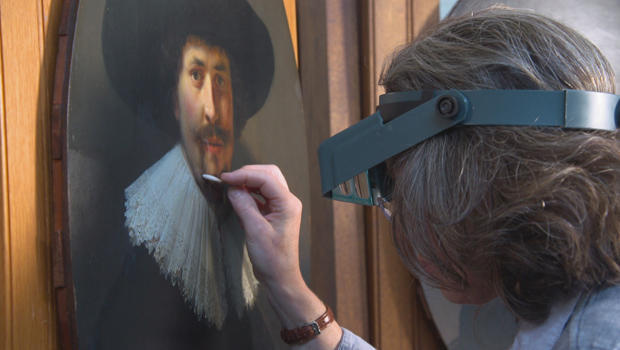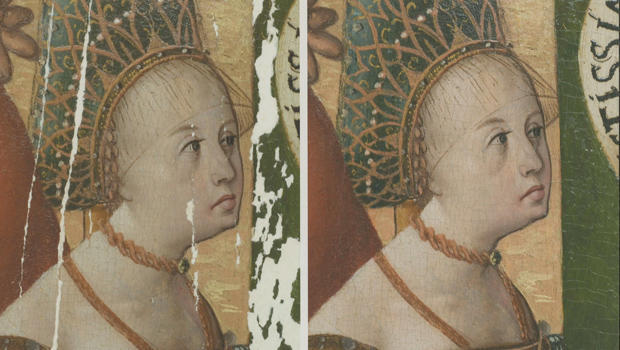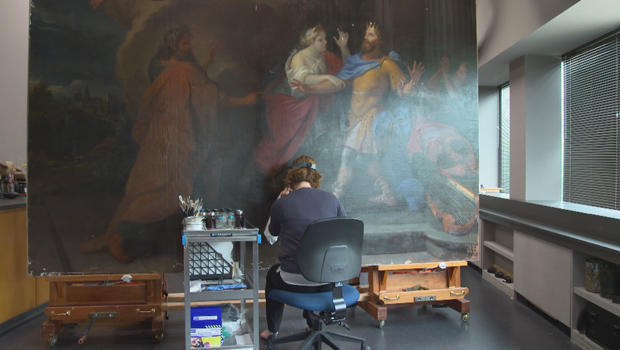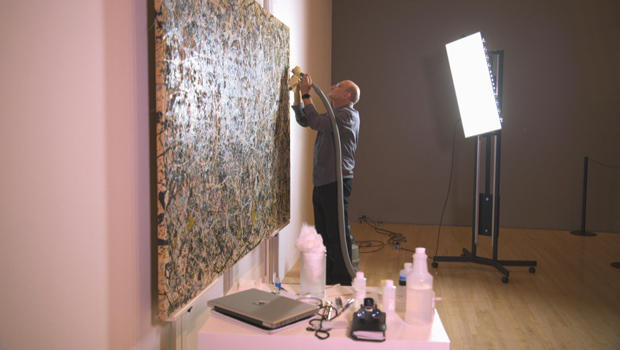Rescuing art: The creativity and science of restoration
Italy's floating city is slowly succumbing to the unrelenting wash of the Adriatic. One of Venice's landmarks, St. Mark's Basilica, is among the hardest-hit by the recent tidal surge – worshipers replaced by water.
Experts can't be sure of the extent of the damage until the flooding recedes, but if any city is prepared to save its treasures from rising water, it's Venice.
- Venice flooding is the worst in 50 years, and the mayor blames climate change ("CBS This Morning")
- Venice government office is flooded minutes after officials reject plan to combat climate change
Art conservators continued working even as the flood waters crept across the floor.
It is that kind of quiet dedication to preserving paintings both old and new that is sometimes overlooked when we're walking through a museum. Paintings, like all of us, age and change; dirt and grime are the more common enemy far more so than flooding or fire.
That's what makes professional art conservators like Rhona Macbeth, at the Museum of Fine Arts in Boston, as valuable as the art they treat.
Correspondent Lee Cowan asked, "It's the artists' intent that drives all of this?"
"As best we possibly can, we want to be true to that idea of artist intent," Macbeth said. "What we're trying to do is take away the barriers between the artist's original vision and the viewer."
To begin removing that barrier is a delicate process, but it's a bit indelicate to demonstrate: she uses her own spit.
Why saliva? "It's an incredibly effective enzyme for removing grime off the surface," Macbeth said. "It works incredibly well."
The day Cowan visited, she was treating two Rembrandts – twin portraits painted in 1634. "They're some of the first Rembrandts to enter any public museum in America, so that's pretty important," she said.
Layers of greying varnish have clouded Rembrandt's intricate bush work, making the unknown couple appear to be staring out from behind a veil. But in the worst cases, like a 16th century altar piece, the paint isn't just dulled … it's actually missing.
Macbeth added white filler where the paint had gone missing: "And then I carve it down to the surface of the paint so it makes a completely smooth transition."
You carve it? "I carve it with little scalpels," she said.
And that's where it gets tricky, because she then has to paint back in what's fallen off.
Cowan said, "I can't tell where it was.
"Well, that's good!" Macbeth replied.
"I think people are surprised to know that some of your work is actually painting in some of what an original artist did. That's kind of shocking to a lot of people, I think."
"I think it is, and I think disturbing, too, sometimes, and I understand that," she said. "But you always have to remember you're not the artist, right? You're not going to make any 'improvements.'"
Allison Langley, the head of painting conservation at the Art Institute of Chicago (where they're working on any number of works, including a massive 17th century French masterpiece), said, "You have to kind of separate yourself in the moment or you'd constantly be in a state of fear!"
"A lot of what we do as conservators is a little bit like 'CSI,'" she said. "We use ultraviolet light, X-ray, infra-red, to examine the surface and look below the surface."
Francesca Casadio is using a macroscopic X-ray to analyze individual pigments in a Vincent Van Gogh painting.
Cowan asked, "What does it actually tell you, the make-up of the paint?"
"It tells us the make-up of the paint, the chemicals in the paint," Casadio said.
Those chemicals are important, because some of the paints that van Gogh used are discoloring over time. The yellow leaves, for example, in the work, "Fishing in Spring," are now more of a mustard color.
Van Gogh's reds have faded, too. Through digital imaging, computers can show us what his "Bedroom" series may have looked like when Van Gogh painted it. Instead of the blue walls we see today, the pigment maybe have actually been closer to violet.
Langley said, "One of the joys of computers is we can change them back without touching the painting. We can do reconstructions digitally."
Even more recent pieces, like a priceless Jackson Pollack, need some TLC, although perhaps a little less scientific. Art restorer Chris Stavroudis was hired by the Museum of Contemporary Art in Los Angeles to make Pollack's drips and dribbles look at vibrant as the day he drizzled them. He uses, among other tools, a vacuum cleaner.
Cowan asked Stavroudis, "Do you ever wonder what Jackson Pollock would think about what you're doing to his painting?"
"Oh, always. And actually, when you're working on any artist's work, you wonder what they would think. But I think the idea of somebody taking the time to conserve his work, making it last for posterity, I think he'd be thrilled.
"It's a very interactive process," he said.
"And intimate, it sounds like," Cowan said.
"Incredibly intimate. It's always funny to think that I will have spent more time looking at this painting than Jackson Pollock ever would have."
Still, there are those who say fine art should just be left alone, that any fading or dirt, or even damage, is part of the natural life of a painting.
Rhona Macbeth said, "You're making choices all the time, and one very legitimate choice is to do nothing. But you have to understand what that choice means. It means accepting the appearance of something which is potentially very different than how it originally looked."
The restoration of the ceiling of the Sistine Chapel was often the subject of sometimes angry debate; some claimed Michelangelo's frescoes were restored too much.
But in the end, the hope of almost any artist is that their work stands the test of time – and the science of conservation is, and has always been, the art of keeping time at bay.
For more info:
- Museum of Contemporary Art, Los Angeles
- Getty Conservation Institute
- Museum of Fine Arts, Boston
- Art Institute of Chicago
- CoOL (Conservation OnLine)
- Art Conservators Alliance
Story produced by Sara Kugel.








